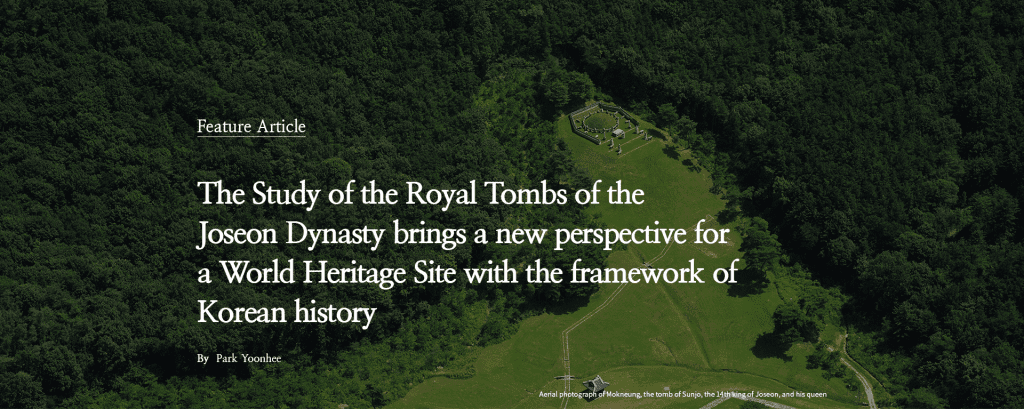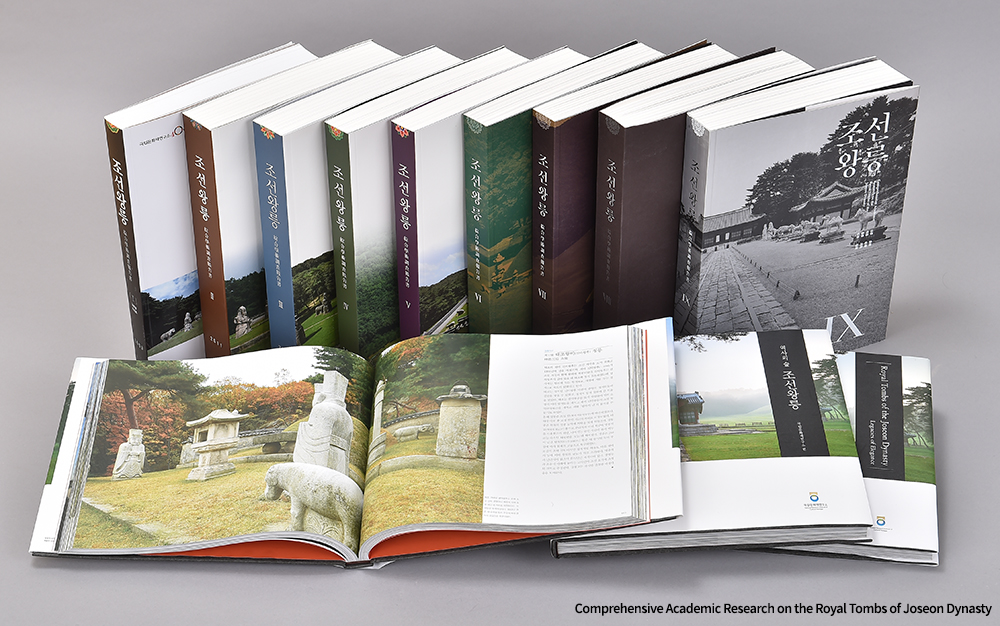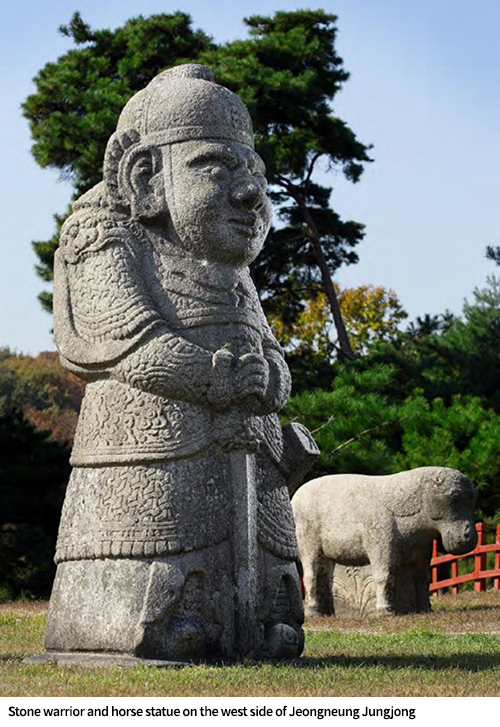PARK Yoonhee


The Royal Tombs of the Joseon Dynasty were built by the state as sacred places based on the Korean traditional notions of nature and Neo-Confucian philosophy. Each tomb is built to honor and respect their accomplishment, well- preserved and asserts their loyal authority, and represents a living tradition of ancestral rites. All given characteristics bring the cultural distinctiveness of these royal tombs stand out among World Heritage sites. Related information is accessible to all via our website “Online Royal Tombs of the Joseon Dynasty.”Artistic Heritage DivisionA thorough examination on the Royal Tombs of the Joseon Dynasty started in 2006, which was undertaken bythe Artistic Heritage Division of the National Research Institute of Cultural Heritage (NRICH). The original purpose was to inscribe them on the UNESCO World Heritage List. Thus, “Research on Stone Sculptures in Royal Tombs of the Joseon Dynasty” started based on a topic that was most relevant to the scope of the Artistic Heritage Division. A common phenomenon was that all royal tombs were parks offering a leisurely respite amidst the urban bustle of modern Korea during that time. As such, no formal studies were available on the subject, with the greatest problem being the lack of precise site survey maps. In order to ensure the inscription of the Royal Tombs of the Joseon Dynasty on the World Heritage List, reference on the most up to date status of the tombs had to be made. The Artistic Heritage Division undertook the task of creating 3D scans and site maps of the following tombs: Geonwolleung Royal Tomb (the tomb of King Taejo), Heolleung Royal Tomb (the tomb of King Taejong) and Jeongneung Royal Tomb(the tomb of Queen Consort Sindeok, the second consort of King Taejo). These efforts were soon followed by the photographing of the 40 surviving Joseon royal tombs in South Korea throughout the four seasons, and by the publication of the Korean and English editions of the book The Forest of History: The Tombs of Joseon’s Kings (2007). The book featured photographs and introductory information about each royal tomb, its layout, and royal ancestral rites. It was sent to the UNESCO Headquarters in Paris, France, and significantly contributed to the serial inscription of the Royal Tombs of the Joseon Dynasty on the World Heritage List in 2009.
World Heritage are properties with Outstanding Universal Value that requires protection for the benefit of humanity, according to the Convention Concerning the Protection of the World’s Cultural and Natural Heritage. World Heritage sites are classified into cultural, natural and mixed sites. To be inscribed on the World Heritage List, not only must a site have Outstanding Universal Value, but the State Party must also demonstrate the implementation of excellent management and protection. Currently, Korea is home to 14 World Heritage sites, ranging from the Seokguram Grotto and Bulguksa Temple (inscribed in 1995) to the Seowon, Korean Neo-Confucian Academies (inscribed in 2019). Among these, the Royal Tombs of the Joseon Dynasty is a large-scale heritage comprising forty tombs (excluding two in North Korea) of kings and queens of the Joseon Dynasty (1392–1910), a royal lineage that lasted for 27 generations over the course of 518 years.
In the evaluation report, UNESCO highly acclaimed the Royal Tombs of the Joseon Dynasty as a serial site that deserves to be inscribed on the World Heritage List, citing that the tombs were built as sacred places by the state according to the traditional view of nature and Confucian ritual principles.
That is, each tomb is complete in and of itself and well-preserved in its original condition. All tombs are associated with a living tradition of ancestral rites, a distinct practice that showcases their distinctive cultural characteristics. The inscription is a feat that resulted from the efforts of not only the Cultural Heritage Administration(CHA), the International Council on Monuments and Sites (ICOMOS) and many advisory experts, but our institution (NRICH) also has strived to inform the world of the unique authentic features and extraordinary quality of Joseon royal tombs.
When the 40 Royal Tombs of the Joseon Dynasty were collectively inscribed on the World Heritage List, several books and guidebooks in relation to those royal tombs came out. The vast majority of them failed to adequately represent its authenticity and mainly focused on the lives of royalty that consist of unproven stories, e.g. secretive political affairs within the royal court. Fundamental aspects of royal family and their history were missing; e.g., the way in which a particular tomb was built at its present location, why it takes on its current form, the people who participated in the entire construction, and common characteristics that are associated with those tombs. Those explanatory questions, along with our need for comprehensive and integrated research on the royal tombs’ history, landscaping, architecture, related literature and bibliography, began to emerge as a lifetime research project. This historical study was, therefore, undertaken by our institution. It was first titled, “Research on Stone Sculptures in Royal Tombs of the Joseon Dynasty,” but later changed to “Comprehensive Academic Research on the Royal Tombs of the Joseon Dynasty.” The reason for this name change was to herald the beginning of comprehensive research. Around that time, the Artistic Heritage Division took another project entitled “Academic Research on Joseon wangjo uigwe (The Royal Protocols of the Joseon Dynasty) for State Designation.” Scholars made a strong connection between the two projects by conducting a bibliographic study of the royal protocols. The study was based on the building of royal tombs, which created synergy. The utilization of high-resolution photography, site surveying, precise 3D scanning, and other advanced technologies produced various forms of data and records on Joseon royal tombs, which provided a solid foundation for the comprehensive research to proceed ahead.


These studies have unveiled different aspects of the Royal Tombs of the Joseon Dynasty that were remained to be unknown. The researchers dispelled the conventional notion that Joseon emulated the styles of Chinese tombs as a vassal state of China. Rather, Joseon royal tombs have their own distinctive characteristics, carrying on the tradition of the royal tombs of the Silla and the Goryeo Dynasties. Historians and archaeologists also accumulated findings on the changes made to the royal tomb system during each historical period and their causes; the stylistic characteristics and historical evolution of tomb components, such as the stone sculptures, jeongjagak (T-shaped wooden shrine) and jaesil (tomb keeper’s house). The NRICH published a nine-volume report series entitled Comprehensive Academic Research on the Royal Tombs of the Joseon Dynasty Volumes I through IX (2009-2015). The series provide detailed information (of the sites and boundaries, spacial arrangements and stone sculptures) on forty-two royal tombs since the late Goryeo period. Those tombs have served as models for Joseon royal tombs, including the Yureung Royal Tomb (i.e.,the tomb of King Sunjong, the last king of Joseon). Several findings based on previous literature opened a new horizon in the study of Korean royal tombs. Those studies had previously been conducted in a sporadic and unsystematic manner.
In 2016, based on the achievement of the comprehensive research on Joseon royal tombs, the NRICH organized and hosted the international symposium “Joseon Royal Tombs & East Asian Imperial Mausoleums,” which shed light on important characteristics and status of the Royal Tombs of the Joseon Dynasty within the larger historical context of royal tombs, as well as imperial mausoleums in China, Vietnam and other parts of East Asia. The NRICH, in collaboration with the National Palace Museum of Korea and the Management Office of the Royal Tombs of the Joseon Dynasty, complied historical record and accumulated data for Joseon royal tombs. Later, the institute hosted the special exhibition Royal Tombs of the Joseon Dynasty, the Resting Places of the Souls of the Royal Family, which gives an opportunity to the public to show great achievements in regards to Joseon royal tombs.
After this data collection, the Artistic Heritage Division conducted a study on diverse topics (i.e., the origin and evolution of stone sculptures in Joseon royal tombs) in relation to its art-historical context. Scholars often define the essence of Korean fine arts as “crafting without crafting” and “unadorned simplicity,” that refers to descriptions illustrating the nature of Korean fine arts. It conveys poise and subtlety hidden against the backdrop of authentic beauty, which is different than more technically-oriented Chinese counterparts and/or more decorative Japanese counterparts. Those Korean aesthetics are well-manifested in the nature-friendly sculptures of Joseon royal tombs. Unfortunately, until recently, research on Korean sculptures was generally confined to Buddhist sculptures, whereas sculptures associated with Joseon royal tombs did not receive proper attention even though their consistent production over the course of more than five centuries had potential to reveal much about the historical context and traditional beliefs. The Artistic Heritage Division’s Stone Sculptures in Royal Tombs of the Joseon Dynasty I & II (2016–2017), provide a comprehensive investigation of the origin, meaning, evolution, and other previously unknown aspects of those sculptures. Stone sculptures in Joseon royal tombs, which were made of granite, look stout and shine brightly Stone animal statues (seoksu) stand around the mound of a royal tomb to supposedly fend off evil spirits. With their faces filled with humor, these statues exude a sense of warmness as if they were alive. Stately stone figures (seoginsang), stone walls (byeongpungseok) and stone lanterns (jangmyeongdeung) feature, at every corner, show a variety of patterns (e.g. peonies, herbs of eternal youth, chrysanthemums, pomegranates and cranes) that illustrate intricate beauty. The book played a significant role in redefining the history of Korean stone sculptures and in informing the world of the unique beauty of stone sculptures in Joseon royal tombs.
In addition to the study on neung(陵) (i.e., the tombs of a king or queen) of the Joseon Dynasty, the Artistic Heritage Division also conducted academic research on royal won and myo tombs of Joseon. Won(園) refers to the category of tomb established for those such as a king’s mother who did not receive the posthumous title of a queen, a crown prince, a crown prince’s eldest son, or a crown prince’s wife. Won tombs were smaller in scale than neung tombs, but were built in a similar manner and were created following higher- level protocols than myo(墓) (the tombs of ordinary members of the royalty). The won system was a unique tomb system of the Joseon royalty, which does not exist in China or Japan. A close comparison of neung, won, and myo tombs is conducive to developing a better understanding of the entire tomb and funeral system of the Joseon royalty—as well as its complicated royal lineage structure and history. The Artistic Heritage Division carried out research on fourteen won tombs and other royal tombs of the Joseon Dynasty that were constructed between the 16th and early 20th century. Its subsequent findings were released as the two-volume report Comprehensive Academic Research on the Royal Won and Myo Tombs of the Joseon Dynasty I & II (2018–2019).


As the last report borne out of the project “Comprehensive Academic Research on the Royal Tombs of the Joseon Dynasty,” the two-volume book is a systematic record of diverse information on won and myo tombs of the Joseon Dynasty, and includes both photographs and survey illustrations. Ever since the inscription of the Royal Tombs of the Joseon Dynasty on the World Heritage List, most academic research primarily focused on neung tombs. As such, just as our report Comprehensive Academic Research on the Royal Tombs of the Joseon Dynasty spearheaded academic research on neung tombs, we hope that its follow-up report, Comprehensive Academic Research on the Royal Won and Myo Tombs of the Joseon Dynasty, will help raise interest in and promote further research on won and myo tombs. The long-term project of the Artistic Heritage Division, “Comprehensive Academic Research on the Royal Tombs of the Joseon Dynasty” commenced in 2006 and continued until 2019. The greatest achievement of the project was the acquisition of some 50,000 items of precious data on the Royal Tombs of the Joseon Dynasty. In particular, precise 3D scanning data, site maps, and aerial photos associated with the forty royal tombs of Joseon as well as with royal won and myo tombs and stone sculptures. Without budgetary support from the government, these precious resources would not have become available. We have decided that our efforts should not be confined to the publishing of reports. Rather, those reports must enhance the utilization of the resulting data. In summary, the NRICH developed the website “Online Royal Tombs of the Joseon Dynasty” ver the course of two years and opened it to the public in November 2018.
Online Royal Tombs of the Joseon Dynasty


“Online Royal Tombs of the Joseon Dynasty” is a website that presents the resources accumulated through the “Comprehensive Academic Research on the Royal Tombs of the Joseon Dynasty” project both comprehensively and systematically. The website is designed to facilitate people’s understanding and study of the history of Joseon royal tombs. It is also user friendly that is easily accessible to all.
Compared to other cultural heritage sites, the Royal Tombs of the Joseon Dynasty brings high level of interest from the Korean public. Academic conferences associated with the subject are always full of interested audiences. People rush to obtain our latest publication on Joseon royal tombs. Despite such high levels of public interest and enthusiasm, scholarly research on this topic is still relatively new. Moreover, the Cultural Heritage Protection Act requires access restriction to the Royal Tombs of the Joseon Dynasty for protection and management, which limits opportunities for acquiring information.
“Online Royal Tombs of the Joseon Dynasty” was developed therefore with the aim of sharing a wide variety of information on Joseon royal tombs with the public. The website also offers a digital experience space, where visitors can experience the royal tombs in a vivid and fascinating way, where they can go beyond space and time to learn about the origins of royal tombs, changes in their characteristics during each period, and their associated historical records via video resources. Visitors can browse through each royal tomb site, observe its stone sculptures and more, with just one click away. An English version of the website is also available, while allowing people around the globe to share academic information on the Royal Tombs of the Joseon Dynasty.
“Online Royal Tombs of the Joseon Dynasty” is the legacy of the Artistic Heritage Division’s “Comprehensive Academic Research on the Royal Tombs of the Joseon Dynasty” project. The current website plays a significant role in offering valuable academic information to our community-at-large. We hope it wil continue to play a vital role in publicizing the valueof the Royal Tombs of the Joseon Dynasty, which is a World Heritage site, to our national and international audiences.






Leave a Reply